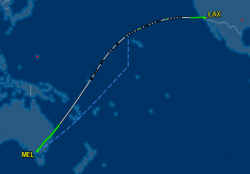Another simulator session complete. This sim was mainly directed at hot weather operations, so thundershower and windshear avoidance.
While it’s still fresh in my mind, here we go...
Day 1
F/O goes first, I had option scenario A or B. I chose A
A was:
MEL – ADL RW27. coughulonimbus in area (thunderstorm avoidance) so instead of following the SID I requested to maintain runway track and went around it. We got held at 5000’ for a TCAS event (Traffic avoidance) then got cleared to climb. Engine OVERHEAT, conducted the memory items, then that quickly escalated to a FIRE on ENG1, memory items conducted again, and after both bottles discharged FIRE light went out. All the usual handling items, stop climb, MAYDAY call with a turn back for MEL. All runways available, we chose 16ILS with a hold at the initial approach fix in case the fire lit up again we could abbreviate the hold and just go straight in. We set up for the approach, established inbound somewhere the glide slope failed so became localiser approach. Shortly before touchdown the engine fire light came on again so that led to an evacuation after landing.
CPT was similar except out of SYD - ADL and a Fuel filter bypass light through transition level. Was basically a contaminated fuel event that led to an immediate return.
Narrow runway ops at Sunshine Coast. Lined up 18, slow speed reject (about 60kts) then reset for high speed reject (10kts prior to V1).
Both did
1: departure MCY with WINDSHEAR,
2: After clear of windshear maintain 3000’ vector for GPS (RNAV RNP X for you aviation buffs out there) RWY18, for landing to cover narrow runway ops, then:
3: reset short final for WINDSHEAR on final
4: up to FL370 for stall recovery
5: jet upset (one nose high with a bank, the other nose low with a bank)
6: limited panel, this is a CASA requirement and all screens had to be failed where even me in the right seat had to fly on the standby instruments in front of the Captain.
Check over.
Day 2
This is the training day. I actually enjoyed this one more than yesterday. More of a management thing and to get us thinking and understand checklists.
Both scenarios were PER - KGI (Kalgoorlie). The Captain had a fuel leak which we identified on the climb and required an engine to be shut down before returning to PER. My scenario was a flap asymmetry, so at Flap 5 retraction, the left Flap jammed at 12° and the other at about 8°. This was a good exercise because it required the correct checklist. There was 3 to choose from. Definitely no rush to get back on the ground so we talked it out, and got back on the ground.
Then it was a bunch of box ticking exercises:
1. Low visibility takeoff. 125m visibility (Capt only)
2. Engine failures after take off (200ft).
3. Circuits.
4. Overspeed management.
End of Day 2. To keep me going, I’ve also got my annual line check in the aircraft on Wednesday, so if you happen to be on VA850 SYD-MEL or VA879 MEL-SYD please say hi so the checkie can’t ask questions on the ground.
















